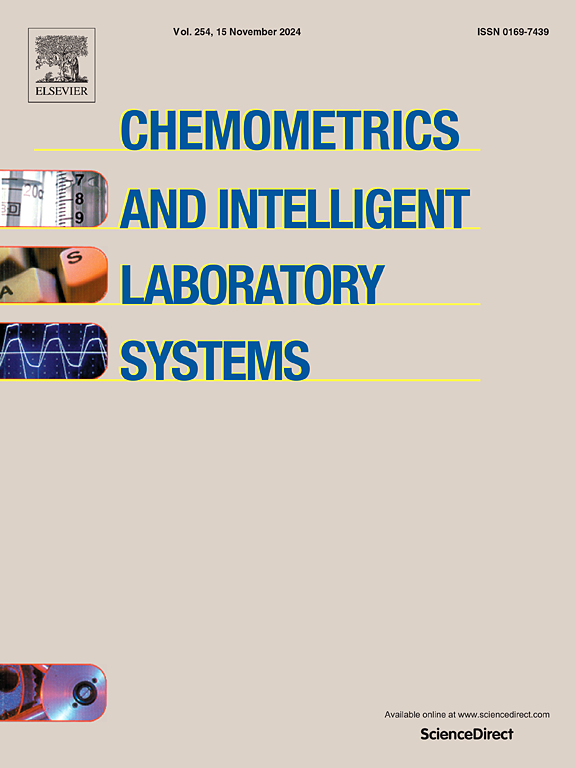A unifying framework for modelling non-negative bi-linear, tri-linear and “in-between” data in chemometrics. Part I: Theoretical framework and concepts
IF 3.8
2区 化学
Q2 AUTOMATION & CONTROL SYSTEMS
Chemometrics and Intelligent Laboratory Systems
Pub Date : 2025-07-24
DOI:10.1016/j.chemolab.2025.105492
引用次数: 0
Abstract
In chemometrics, extracting chemically meaningful information from multi-way analytical data is often challenged by deviations from ideal tri-linear structure of the chemical information. This work introduces a novel modeling approach based on (1, , ) block term decompositions, which flexibly bridges the gap between bi-linear and tri-linear models. The method builds upon the MCR-tri-linearity framework and leverages uniqueness conditions established by De Lathauwer to ensure interpretable factor solutions under practical conditions. A rank-constrained alternating optimization algorithm is proposed to adaptively determine the number of principal components needed for reconstructing varying-mode factors, based on a user-defined reconstruction error tolerance. This adaptive decomposition balances the essential uniqueness of tri-linear models with the flexibility of bi-linear approaches, addressing limitations in both. Simulated data with controlled component ranks demonstrate the method's ability to recover ground-truth factors more accurately than classical tri-linear models, while reducing ambiguity compared to bi-linear models. The results confirm that the proposed approach provides an effective framework for analyzing multi-way chemical data with partial or full deviations from tri-linearity, making it a promising tool for a wide range of chemometric applications.
一个统一的框架建模非负的双线性,三线性和“中间”的数据在化学计量学。第一部分:理论框架和概念
在化学计量学中,从多路分析数据中提取有意义的化学信息常常受到偏离理想的化学信息三线性结构的挑战。本文介绍了一种基于(1,Lr, Lr)块项分解的新型建模方法,该方法灵活地弥补了双线性和三线性模型之间的差距。该方法以mcr -三线性框架为基础,利用De Lathauwer建立的唯一性条件,确保在实际条件下因子解是可解释的。提出了一种基于自定义重构容差的秩约束交替优化算法,自适应确定重构变模因子所需的主成分个数。这种自适应分解平衡了三线性模型的本质独特性和双线性方法的灵活性,解决了两者的局限性。具有控制分量秩的模拟数据表明,该方法比经典三线性模型更准确地恢复地面真值因子,同时与双线性模型相比减少了模糊性。结果证实,该方法为分析部分或全部偏离三线性的多向化学数据提供了一个有效的框架,使其成为广泛的化学计量学应用的有前途的工具。
本文章由计算机程序翻译,如有差异,请以英文原文为准。
求助全文
约1分钟内获得全文
求助全文
来源期刊
CiteScore
7.50
自引率
7.70%
发文量
169
审稿时长
3.4 months
期刊介绍:
Chemometrics and Intelligent Laboratory Systems publishes original research papers, short communications, reviews, tutorials and Original Software Publications reporting on development of novel statistical, mathematical, or computer techniques in Chemistry and related disciplines.
Chemometrics is the chemical discipline that uses mathematical and statistical methods to design or select optimal procedures and experiments, and to provide maximum chemical information by analysing chemical data.
The journal deals with the following topics:
1) Development of new statistical, mathematical and chemometrical methods for Chemistry and related fields (Environmental Chemistry, Biochemistry, Toxicology, System Biology, -Omics, etc.)
2) Novel applications of chemometrics to all branches of Chemistry and related fields (typical domains of interest are: process data analysis, experimental design, data mining, signal processing, supervised modelling, decision making, robust statistics, mixture analysis, multivariate calibration etc.) Routine applications of established chemometrical techniques will not be considered.
3) Development of new software that provides novel tools or truly advances the use of chemometrical methods.
4) Well characterized data sets to test performance for the new methods and software.
The journal complies with International Committee of Medical Journal Editors'' Uniform requirements for manuscripts.

 求助内容:
求助内容: 应助结果提醒方式:
应助结果提醒方式:


